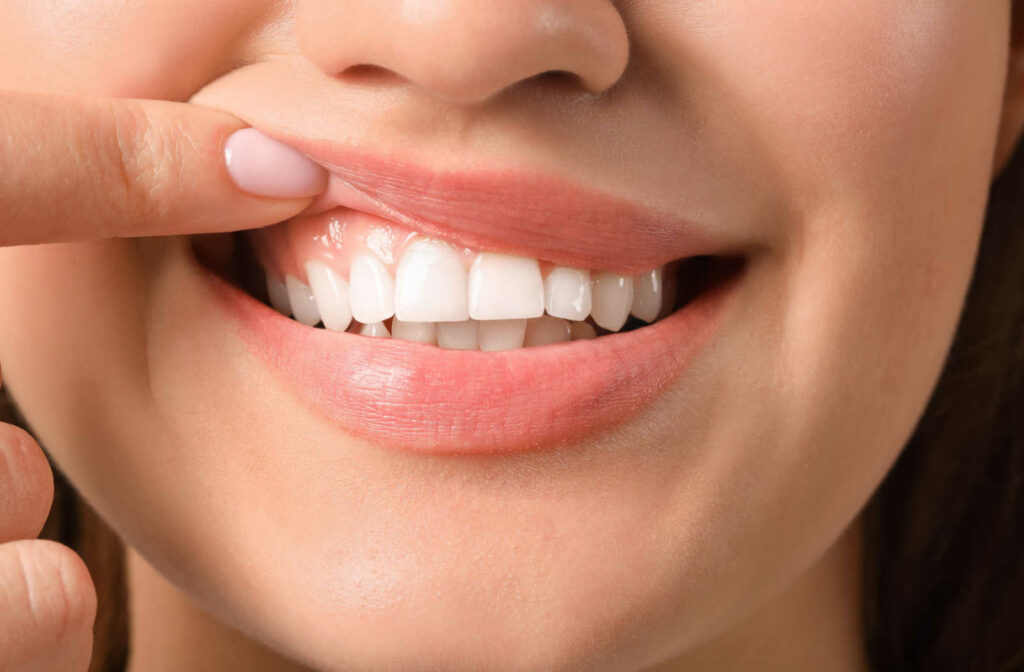When you brush your teeth and floss, are you checking your teeth for signs of oral health problems? What would these signs even look like? And what are your options when you do notice an oral health problem?
Oral care is an everyday part of our lives, but it might be too easy sometimes to get swept up in the habit of your regular dental routine to notice the little things. This is why regular dental exams and cleanings are so important, as they can help spot these concerns early in their development. But if you’re concerned about your oral health, one of the most common signs of gum disease is receding gums.
Today, we’ll walk you through how receding gums develop and explore how you can help prevent this issue in yourself or your loved ones.
If you’re concerned about a current oral health problem, please book an appointment today. Our team at Palermo Village Dental will be happy to help you and your family maintain your beautiful smiles today, tomorrow, and beyond.
Gum Disease Causes Receding Gums
Gum disease is among the most common oral health problems Canadians face, and it occurs over the course of several different steps. And while these steps happen over time, they can lead to permanent issues that only a dentist can help treat or manage.
Let’s look at how gum disease develops:
Plaque & Tartar
The very first step starts with plaque. Plaque is a clear and sticky film of bacteria that coats the surface of your teeth. Plaque accumulates from the foods and drinks you consume, but you can easily manage it by brushing and flossing regularly.
However, if you don’t brush enough, plaque on your teeth can harden into tartar over time, which, in turn, can lead to gingivitis, also known as gum disease. Tartar can only be removed by oral hygienists and cannot be managed with traditional brushing and flossing.
Gingivitis
The bacteria in tartar slowly eat away at your tooth’s enamel, which acts as a protective layer. If it reaches your dentin, it can then form a cavity. Cavities can lead to several other oral health problems, like tooth infections and gum disease.
Other issues can include:
- Bad breath
- Bleeding gums
- Redness
- Puffiness
If gingivitis continues to develop without intervention, it can cause an infection that targets and destroys gum tissue.
Receding Gums & Tooth Loss
As gingivitis affects your gums, your gums will start to recede. And as they recede, you can develop a risk of tooth loss over time.
You might be at risk of losing a tooth if you:
- Start to notice your teeth getting longer
- You see the root of your tooth
- Your teeth become loose over time
If you lose a tooth, you may need a procedure to restore your smile’s look and functionality. These procedures can include crowns, bridges, or dental implants. Your dentist can then discuss which option is most suitable for you and your oral health needs.
Gum Disease Risk Factors
While poor oral health care may be the most common cause of gum disease, receding gums, and tooth loss, other issues may contribute to your risk. In fact, 7 in 10 adults can expect to face gum disease at some point in their life.
Nevertheless, some of the most common risks can include:
Genetics
If your family has a long history of developing oral health problems, then you might have a higher risk of experiencing gum disease. In fact, some studies suggest that 30% of the country’s population may have a higher risk of gum disease because of their genetics, even if they take good care of their teeth.
Poor Oral Health Techniques
How you brush and floss your teeth can also increase your risk of developing gum disease.
If you brush too lightly or not enough, you might not brush off enough plaque to prevent it from becoming tartar. If you brush too hard or for a very long time, you might affect the enamel on your teeth and expose your dentin to gum disease-causing bacteria.

Managing Your Risk
Brushing & Flossing
Brushing and flossing are the first steps in preventing gum disease and other oral health problems.
According to the Canadian Dental Association, most dentists recommend brushing your teeth at least twice a day and flossing at least once a day.
See a Dentist Regularly
Regular dental exams and cleanings are arguably the most important part of your oral health care routine. During your comprehensive appointment, your dentist looks for several potential oral health problems alongside gum disease and tooth decay.
These concerns can include:
- Loose teeth
- Misaligned teeth or bite
- Oral cancer
Seeking Treatment
There are several different treatments available that can help address or even prevent gum disease and tooth loss. These treatments can include:
Your dentist can help determine which strategy may be best for you when you come in for an appointment.
Book Your Appointment Today
Just because oral health care is part of your everyday routine doesn’t make it any less important to manage. Discover how you can better support your shining smile today and book an appointment with the team at Palermo Village Dental.
With the help of our compassionate and personalized care strategies, we’re ready to help you enjoy the confident, glowing smile you deserve. Book your appointment today!




